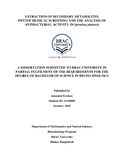| dc.contributor.advisor | Chowdhury, Jebunnesa | |
| dc.contributor.author | Ferdaaus, Jannaatul | |
| dc.date.accessioned | 2016-01-17T16:23:50Z | |
| dc.date.available | 2016-01-17T16:23:50Z | |
| dc.date.copyright | 2015 | |
| dc.date.issued | 2015-10 | |
| dc.identifier.other | ID 11136005 | |
| dc.identifier.uri | http://hdl.handle.net/10361/4869 | |
| dc.description | This thesis is submitted in partial fulfillment of the requirements for the degree of Bachelor of Architecture, 2015. | en_US |
| dc.description | Cataloged from PDF version of thesis report. | |
| dc.description.abstract | Spirulina platenis is a multicellular and filamentous blue-green microalgae which is most well-known and broadly accessible. It develops in water, can be reaped and prepared effortlessly and has fundamentally high large scale and micronutrient substance. In numerous nations of Africa, it is utilized as human nourishment as a critical wellspring of protein and is gathered from normal water, dried and eaten. It has increased impressive prevalence in the human wellbeing nourishment industry and in numerous nations of Asia it is utilized as protein supplement and as human wellbeing sustenance. Spirulina has been utilized as a reciprocal dietary element of food for poultry and progressively as a protein and vitamin supplement to aquafeeds. Spirulina seems to have significant potential for improvement, particularly as a little scale crop for wholesome upgrade, employment advancement and ecological alleviation. In the current research work , the crude extracts of Spirulina platensis were collected using three solvents namely- Methanol , Ethanol and Distilled Water and phytochemical assay was performed on it to identify the secondary metabolites present in them. Antimicrobial activity was performed on the three types of crude extracts (which were initially diluted with Dimethyl Sulfoxide -DMSO) against Bacillus subtilis, Enterococcus faecalis , Staphylococcus aureus , Escherichia coli, using a positive (antibiotic disk) and negative control (0.25% DMSO), The antimicrobial tests were carried in agar diffusion technique using Mueller Hinton Agar (M-H) media. The results obtained from this study can act as a stepping stone in investigating the antimicrobial properties of Spirulina platensis extracts. This study could be the beginning of discovering a new microbial agent against certain bacterial species. | en_US |
| dc.language.iso | en | en_US |
| dc.publisher | BRAC University | en_US |
| dc.rights | BRAC University thesis are protected by copyright. They may be viewed from this source for any purpose, but reproduction or distribution in any format is prohibited without written permission. | |
| dc.subject | Biotechnnology | en_US |
| dc.title | Extraction of secondary metabolites, phytochemical screening and the analysis of antibacterial activity in Spirulina platensis | en_US |
| dc.type | Thesis | en_US |
| dc.contributor.department | Department of Mathematical and Natural Science, BRAC University | |
| dc.description.degree | B. Biotechnnology | |

